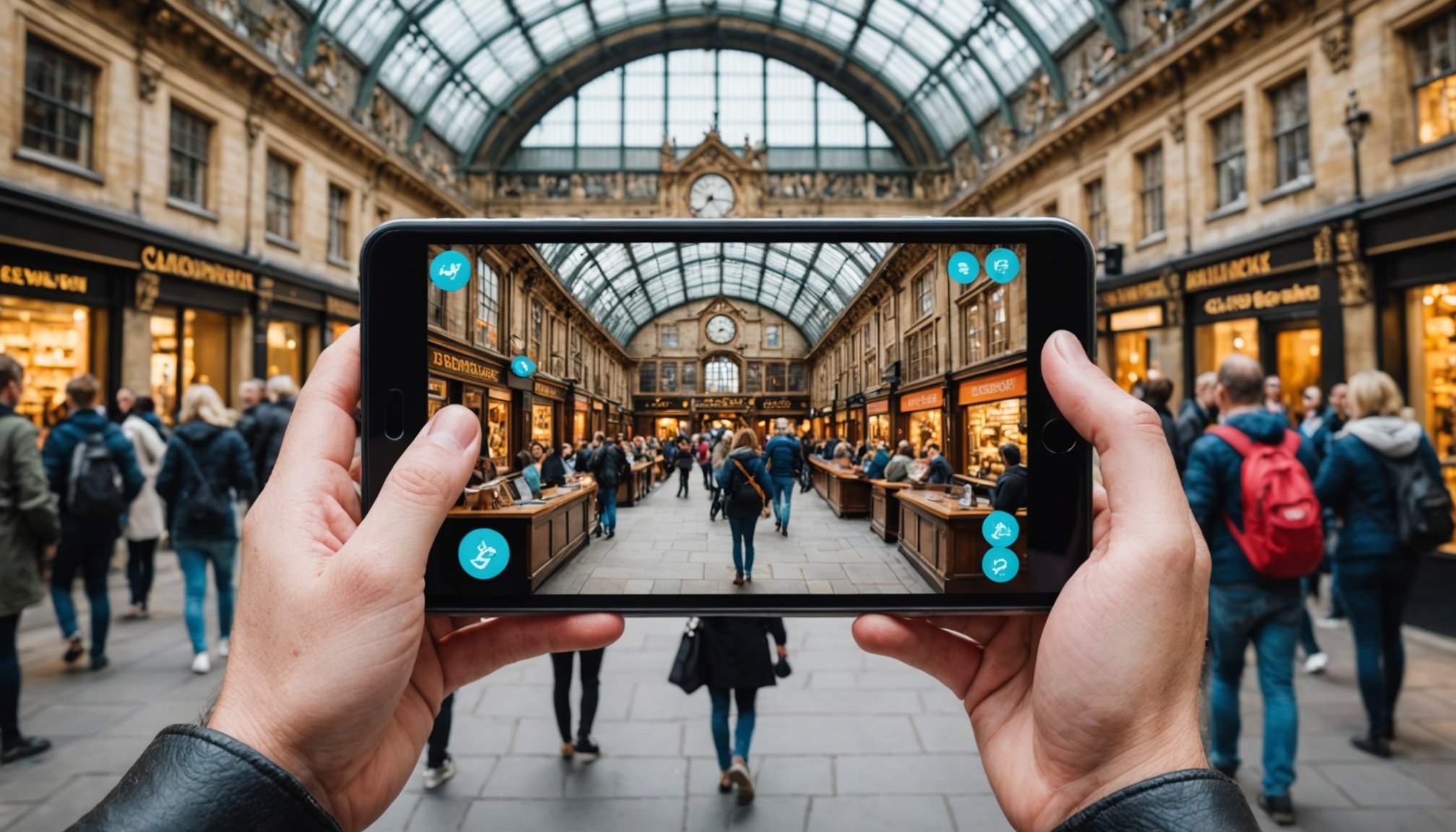The Impact of Augmented Reality on Visitor Engagement
Augmented Reality (AR) is revolutionising the tourist experience by enhancing visitor engagement at attractions worldwide. This technology overlays digital information onto the real world, providing a more immersive experience. When questioned about the effectiveness of AR in tourism, statistics show that attractions using AR have experienced increased interaction levels. In fact, some attractions report a visitor engagement rise by up to 60%.
AR’s appeal lies in its ability to make the tourist experience more interactive and personalised. For instance, historical sites come to life with AR, allowing visitors to see past scenes in their current settings. This level of engagement not only enriches the visitor’s experience but also boosts learning and retention, turning passive observation into active participation.
A closer look at specific UK attractions reveals AR’s tangible benefits. Notable case studies include augmented tours at popular historical sites where visitor numbers have grown substantially post-AR implementation. These sites have received positive feedback from visitors, as they appreciate the detailed narratives and visualisations AR provides.
AR transforms static exhibits into dynamic experiences, offering tourists unique immersion opportunities that traditional methods cannot match. By fostering deeper connections, AR promises a vibrant future for visitor engagement.
Also read : Unlocking Geomarketing Potential: Key Strategies for UK Retailers to Propel Business Growth
Case Studies of Successful AR Implementation
Augmented Reality (AR) is being celebrated for transforming the tourist experience across numerous UK attractions. Thanks to AR applications, sites such as museums and historical landmarks have witnessed a surge in visitor numbers and engagement levels. These case studies provide insight into the tangible benefits that the technology brings.
Landmark Examples of AR Usage
In London, the Tower Bridge exhibition incorporates interactive AR elements, allowing visitors to visualize its historical importance. Such AR features have enhanced visitor feedback and are a prime example of successful integration. Visitor numbers have steadily increased since the introduction of AR, showcasing the technology’s power to attract a wider audience. At Edinburgh Castle, AR applications bring ancient tales to life, immersing tourists in historic battles visually represented through AR. Visitors express appreciation for these enrichments in their feedback, highlighting the engaging narratives and realism provided by the technology.
Comparative Studies
Assessing experiences before and after AR implementation reveals notable improvements in visitor engagement. The diversity in AR applications, from 3D models to interactive stories, has taught valuable lessons about delivering standout experiences. These UK attractions exemplify how tailored AR experiences can enhance understanding and appreciation of cultural heritage, amplifying the visitor experience significantly.
The Impact of Augmented Reality on Visitor Engagement
Augmented Reality (AR) has become a game-changer in the tourism industry, fundamentally altering how visitors interact with attractions. By overlaying digital elements onto physical environments, AR offers an enriched tourist experience. Statistics highlight that sites employing AR technology have seen a remarkable increase in visitor engagement, with some reporting boosts of up to 60%. This surge illustrates AR’s compelling ability to capture and hold the attention of tourists.
At popular UK attractions, this innovative technology transforms static displays into captivating spectacles. For instance, AR applications at historical sites allow guests to witness past events, bringing history to life in astonishing ways. Visitors who experience these immersive environments frequently express greater satisfaction and learning retention.
Augmented Reality is particularly beneficial in creating personalised experiences. The ability to tailor the content to individual preferences means that each visitor can engage with information that resonates with them personally. This not only enhances the overall visitor experience but also encourages repeated visits and recommendations. By transforming traditional attractions into interactive experiences, AR is poised to redefine visitor engagement, paving a successful path for the future of tourism.
Enhancing Education Through AR Experiences
Augmented Reality (AR) not only captivates audiences but also transforms traditional learning into immersive learning experiences. This revolution in visitor education offers interactive engagement with information in ways that were previously unimaginable.
For instance, educational tours incorporating AR allow visitors to interact with digital reconstructions of historical artifacts, fostering profound educational experiences. Imagining Roman soldiers marching through Britain’s ancient roads or witnessing Shakespeare’s London, AR provides a dynamic way to learn about history and culture. Such visualizations provide a deeper understanding of the subject matter and ensure that educational content is memorable and engaging.
Expert opinions consistently highlight the benefits of AR in enhancing visitor education. Many educators agree that AR technology significantly boosts knowledge retention and stimulates curiosity. They suggest that by catering to various learning styles, AR creates an environment where users can connect with the material more personally and meaningfully.
Examples of successful integration include museum apps that guide users through exhibits, providing context and stories tied to the displayed artifacts. These educational experiences enhance the educational journey by merging digital information with tangible exhibits, offering visitors a richer understanding of the topics at hand.
Potential Drawbacks of Augmented Reality
Augmented Reality (AR) impressively enhances the tourist experience, yet several challenges must be addressed to ensure visitor safety and enjoyment. A primary concern centers on the potential for over-reliance on technology. While AR offers immersive benefits, excessive dependence may detract from physically engaging with attractions and the surrounding environment.
Privacy and data security also present significant concerns. As AR applications often collect and process personal data to provide personalised experiences, ensuring data protection is paramount. Tourist sites must adopt robust security protocols to safeguard visitor information and maintain trust in AR technology.
Feedback from visitors sometimes highlights negative experiences related to dizzying effects or technological misfires. Technology can falter, leaving users disoriented if digital content does not align perfectly with physical elements. Attractions must ensure that AR systems are well-calibrated to prevent such occurrences.
Balancing visitor safety with technological innovation requires careful planning. By proactively addressing these concerns, attractions can minimise drawbacks of AR and maximise the enriching experiences AR promises. Although challenges exist, understanding and navigating them paves the way for a safer, more engaging future in AR tourism.
Expert Opinions and Insights
Discussion around Augmented Reality (AR) in tourism is deeply enriched by the perspectives of industry experts. These professionals illuminate AR’s future trajectory and its inherent balance between educational value and entertainment. Many experts agree that AR presents an invaluable tool for the tourism sector, offering unique advantages in enhancing the tourist experience.
Interviews with industry leaders consistently highlight AR’s potential to revolutionise how attractions deliver educational content. These leaders believe that by combining technology with storytelling, visitors enjoy a more engaging and educational interaction with content. They remark that AR can turn static information into dynamic experiences, fostering deeper visitor engagement.
Experts also provide nuanced views on the importance of balancing education with entertainment. While entertainment elements are crucial for capturing visitor attention, the educational aspect ensures that experiences remain meaningful and enriching. On the practical side, professionals advise attractions to prioritize seamless AR development, ensuring technology does not overshadow the experience but complements it.
For attractions considering AR integration, industry experts recommend assessing visitor needs meticulously. They suggest trials and iterative improvements to optimize AR features, emphasizing the necessity for robust infrastructure and a clear understanding of the target audience to succeed in this tech-driven adventure.











